“On a hill far away, stood an old rugged cross, the emblem of suffering and shame”
Evangelical Hymn, George Bennard, 1913
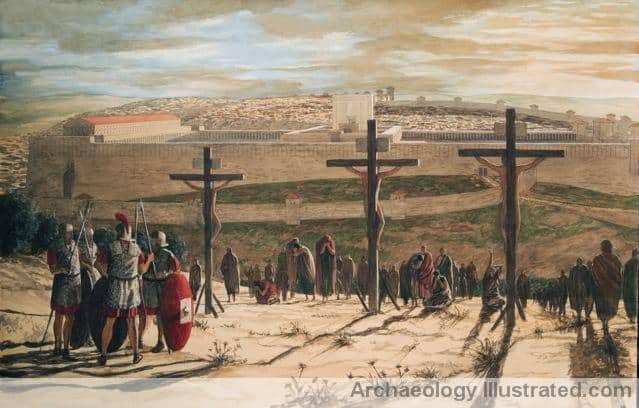
According to all our historical records Jesus was crucified somewhere outside the city wall of Jerusalem. He was sentenced to death by the Roman prefect of Judea, Pontius Pilate, at the Praetorium, which we can now locate at the western entrance to Herod’s place, see my recent post, “Standing Again with Jesus: Ecce Homo Revisited.” Mark, our earliest record, then says:
And they led him out to crucify him. And they compelled a passerby, Simon of Cyrene, who was coming in from the country, the father of Alexander and Rufus, to carry his cross. And they brought him to the place called Golgotha, which means Place of the Skull. (Mark 15:21-22)
Matthew and Luke repeat Mark, who was their source. John also names the place as Golgotha–place of the Skull, but he adds a detail, “the place where Jesus was crucified was near the city,” thus visible to passersby (John 19:20). Golgotha is Aramaic for Skull. The more familiar name Calvary is based on the Latin Calvariae, or Skull, the word Jerome used when he translated the gospels into Latin. How or why the place got this name is unknown to us. There is a late Jewish tradition, known also by Christian fathers like Origen, that Adam’s skull was buried in Jerusalem, which accounts for the tradition so common in medieval art of placing a skull at the foot of the cross. Some have speculated that the name might be related to “Goliath,” based on the text of Samuel that mentions David bringing his severed head to Jerusalem (1 Samuel 17:54). Others have seen the name as describing a despicable place of execution, where skulls and bones would be strewn about. Still others, have seen it more as a physical description–perhaps of a craggy rock-like hillock that gave the appearance of a skull. [1]Thanks to Bill Sulesky for pointing out that Julius Caesar was also buried at a “place of the skull,” according to Appian, Civil Wars bk 2: “The people returned to Caesar’s … Continue reading
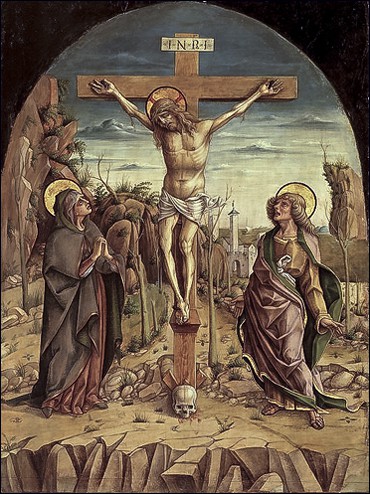
What none of these texts explicitly say is anything about a hill called Golgotha or Calvary, which is so familiar in Christian tradition, but as we will see, that notion does have support in other texts.
So the question is–where is Golgotha? Can it be located? And why would it be called the “place of the Skull.” There are two traditional sites in Jerusalem that tourists and pilgrims revere as its likely location.
The oldest and most revered is of course the 4th century Church of the Holy Sepulchre, the holiest site in Christendom, honored by Roman Catholics, Greek Orthodox and other Eastern branches of Christianity. It is located in the Christian Quarter, inside the present Old City walls and was built by queen Helena, the devout mother of Constantine, the first Christian Emperor. Roman Catholics, Eastern Orthodox, Armenian, and Coptic Christians share the veneration and operation of the site. In the time of Jesus the area was a rock quarry and was just outside the northern city wall. The problem with this location, despite its overwhelming favor with both Christian believers and a score of scholars who have written on the subject, is there is no connection of Jesus to the site before the early 4th century–approximately 300 years after the time of Jesus. Helena, the pious mother of Constantine, the Roman Emperor, is the first one to give it her stamp of approval and consecrate it as the location of Golgotha, but it has little or no other basis in any of our historical records.
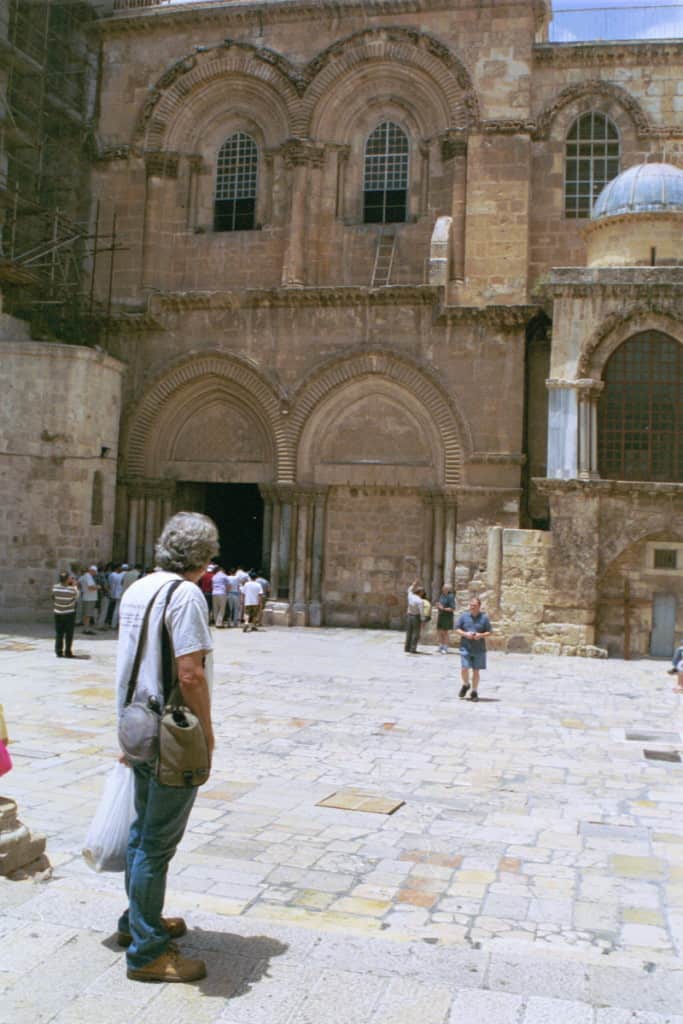
Many Protestants prefer an alternative site, outside the Old City walls, just north of the Damascus Gate near the bus depot. It is commonly referred to as the “Gordon’s Calvary” or the Garden Tomb, after its “discoverer,” the British general Charles “Khartoum” Gordon. Gordon suggested the location on a visit to Jerusalem in 1882, impressed by the elevated craggy rock outcropping that he thought resembled a skull, and a nearby ancient tomb with an entrance sealed with a rolling stone. The main problem with this site is that the tomb adjacent to this hill has been definitively dated to the Iron Age, which would preclude it being the newly hewn tomb used by Joseph of Arimathea in the time of Jesus.
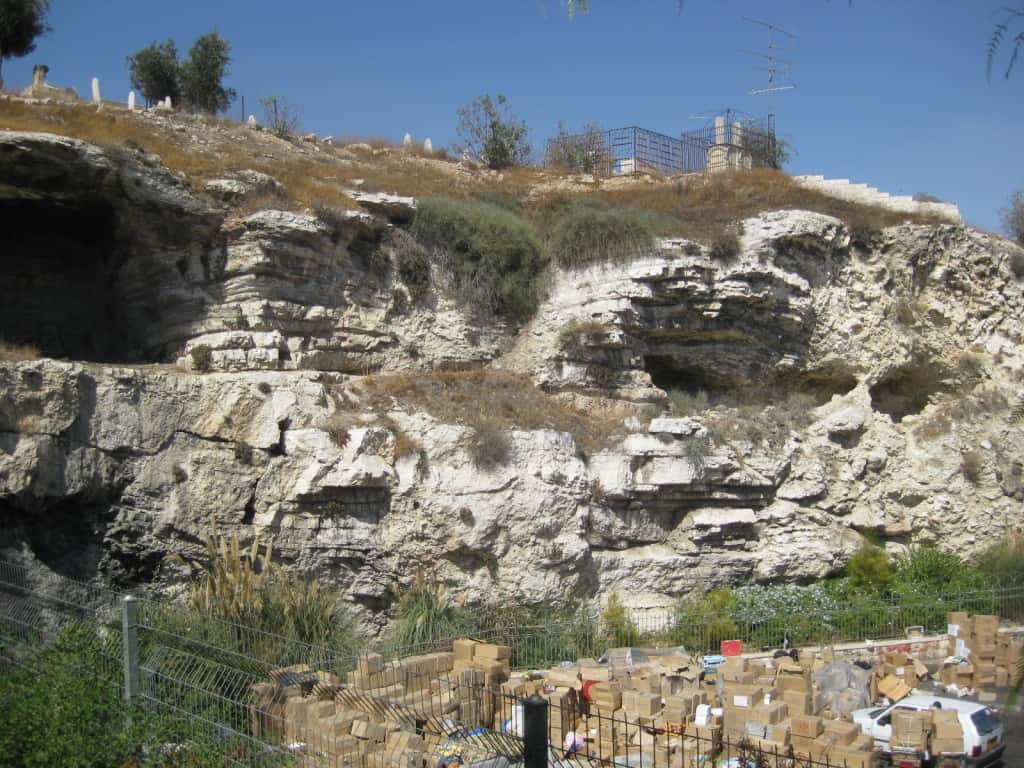
Some years ago I encountered the view that the crucifixion took place on the Mount of Olives, as expressed in a little book published by the late Ernest Martin titled The Place of Christ’s Crucifixion: Its Discovery and Significance (Foundation for Biblical Research, 1984). This book is long ago out of print though used copies can still be found at Amazon and other sources.
Although Martin independently came to his view that the crucifixion of Jesus took place on the Mount of Olives, after publishing his first work he discovered the views of Nikos Kokkinos (1980) who had developed a somewhat different argument related to the notion that the crucifixion would have taken place at the scene of Jesus’ arrest, based on Roman law, thus near the Garden of Gethsemane at the foot of the Mt of Olives. Later Martin also noted the views published by Dr. N. F. Hutchinson in the Palestine Exploration Quarterly “Notes on our Lord’s Tomb” (1870, 379-381), and “Further Notes on our Lord’s Tomb” (1873, 113-115), who might have been the first to argue, at least in modern times, that both the site of the crucifixion, and the tomb in which he was first placed, must have been east of the city–quoting Hebrews 13:11-12. Hutchinson puts forth a number of other arguments: that it was on a “high road” visible to all, leading past gardens; that the scene could be witnessed “from afar off” by bystanders, and that it was on a main road upon which throngs of pilgrims arrived for the feast (from Jericho, through Bethany, to Jerusalem), rather than from the south or west. Their first view of the city was when they crested the Mt of Olives and behold the Temple in its splendor. Hutchinson asserts that none of these descriptions fit the Western part of the city. In his subsequent note he observes that according to Melito of Sardis, Mary, the mother of Jesus, is also associated with the Mt of Olives in later tradition, including her own tomb near that of her son, and that she “went out every day” to pray at the tomb of Christ and at Golgotha–which implies close proximity to the Mt of Olives.
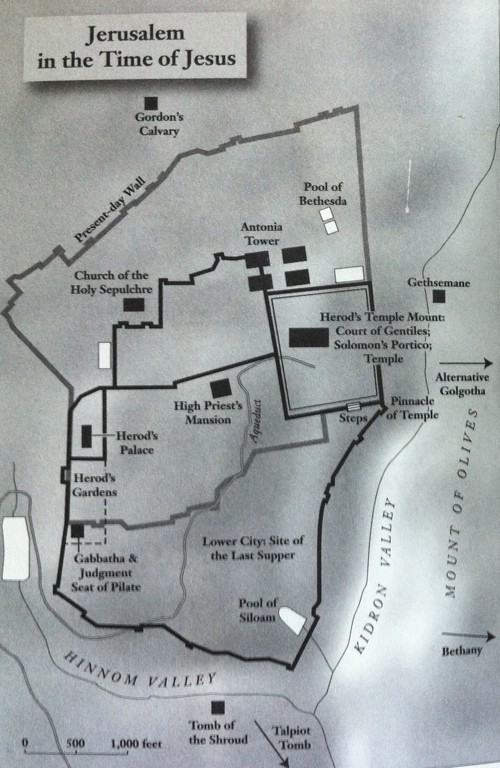
The basic case for the Mt. of Olives being the site of Jesus’ crucifixion rests on several interrelated arguments of varying evidential strength.
1) The first, and in my view, the most weighty, is a passage in the New Testament book of Hebrews (13:10-13) that speaks of “going outside the city gate,” to a specific altar that was not inside the Temple, but “outside the camp.” This is a clear and unmistakable reference to the Eastern Gate, leading to the Mt of Olives, and the Miphqad altar located on its slopes. It was at this spot that the Red Heifer (parah ‘adamah) was burnt to provide the essential ashes for cleansing all things related to Temple worship (Numbers 19). The Talmud and Mishnah are clear that this altar was located 2000 cubits, outside the Eastern Gate, on the slopes of the Mt. of Olives (bYoma 68a, mSanhedrin 6:1). The author of the book of Hebrews makes use of this essential sacrificial practice, “outside the camp,” to establish the legitimacy of Jesus being crucified “outside the gate.” Rather than a gate on the north of the city, the Eastern Gate is really the only one that would make sense in this passage. This image of the Red Heifer, that had to be “without spot or blemish” was picked up by the early Christians as the most fitting allegorical image of Jesus’ own cleansing sacrifice, with the “sprinkling” of his blood likened to that of the water prepared with the ashes of the Red Heifer. The writer of Hebrews, preserving pre-70 CE traditions, subsequently lost after the destruction of two Jewish Revolts and the establishment of Jerusalem as Aelia Capitolina by Hadrian, seems to be reflecting some actual take on the geography of Jerusalem and is able to make a very effective point to his readers based on Jesus being crucified east of the city, outside the gate, on the Mt. of Olives.
2) The Acts of Pilate (aka Gospel of Nicodemus IX.5) preserves a tradition that Jesus was sent away by Pilate with two malefactors named Dysmas and Gestas, to be crucified in the garden where he was arrested–Gethsemane, which all our gospel sources agree was across the Kidron on the slopes of the Mt of Olives. As Prof. Kokkinos demonstrated, this was in keeping with Roman law.
3) The Hebrew Gospel of Matthew (preserved by Ibn Shaprut in his work Even Bohan), published by George Howard, refers to the site of the crucifixion, in Hebrew, as Har Golgotha, which means a “mountain” or “hill,” and certainly not the little outcropping of rock preserved at the stone quarry where the Church of the Holy Sepulchre now stands. This is one of our earliest records of Golgotha being called a “hill” or “mountain,” which seems to have become a popular notion in Christian lore and legend down through the ages.
4) Josephus says that during the Jewish revolt (66-70 CE) as many as 500 Jewish victims per day were crucified “before the wall of the city,” in order to terrorize the population (War 5:289; 5:449-450). A first century Roman writer notes “When we crucify criminals the most frequented roads are chosen, where the greatest number 0f people can look and be vexed by this fear. For every punishment has less to do with the offense than with the example” (Ps. Quintilian, Declamationes maiores 274.13 trans. LCL). This description fits perfectly with the Mt. of Olives, before the main city gate, with the Romans camped just to the north on Mt Scopus. This was the only location that could be seen by anyone in the city of Jerusalem, and the week Jesus died it would be visible to passersby arriving from all directions for the Passover feast, thus providing a visible warning to those who might be tempted to sympathize with rebels.
The traditional site of the Church of the Holy Sepulchre fits none of this evidence. By the time Constantine’s mother, queen Helena came to Jerusalem, in the early 4th century, there was no memory of the original tomb of Jesus or the site of the crucifixion, as that oral tradition, that would have belonged to the Jerusalem Church, led by James and Simon, brothers of Jesus, had long ago perished. The tomb and monument area she was shown, by a stone quarry, most likely was the tomb of John Hyrcanus, that is often mentioned by Josephus as precisely in that area.
Back in 2005 when I was working on The Jesus Dynasty I commissioned the extraordinary artist Balage Balogh to paint the crucifixion scene on the Mt. of Olives based on my own exploration of the siteI had located a bedrock area, flat and just above the site of the miphqad altar, that seemed to me to be an idea location for crucifixion as alluded to in the book of Hebrews and “in front of the city wall” as Josephus indicated. It is directly in front of the Eastern Gate, looking into the courtyard of the Temple. Nearby are lots of 1st century tombs, as well as an oil-press (Gethsemane/Gat Shemen means “press of oil), and lots of Olive Orchards. None of these features fit the quarry area just north of the 1st century city wall, where the Church of the Holy Sepulchre stands today.

The image of Jesus dying, overlooking the city of Jerusalem, on the very slopes of the mountain he had ridden down a week earlier on the donkey, hailed by the crowds as the harbinger of the kingdom of David, is surely one of the most touching scenes imaginable. To this day there is a steep path on the north slope that goes up to this area of crucifixion that I have proposed and a southern path that goes down, from Bethany, both worn deep into the bedrock.








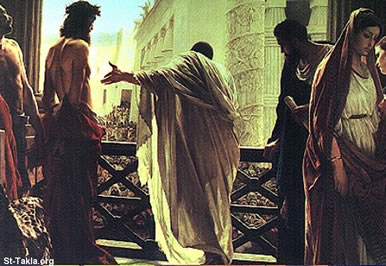
Comments are closed.